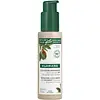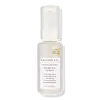What's inside
What's inside
 Key Ingredients
Key Ingredients

 Benefits
Benefits

 Concerns
Concerns

 Ingredients Side-by-side
Ingredients Side-by-side

Water
Skin ConditioningCetearyl Alcohol
EmollientEthylhexyl Palmitate
EmollientDicaprylyl Carbonate
EmollientBehenamidopropyl Dimethylamine
EmulsifyingTheobroma Grandiflorum Seed Butter
Skin ConditioningTocopheryl Acetate
AntioxidantSodium Hyaluronate
HumectantAlpha-Isomethyl Ionone
PerfumingBenzoic Acid
MaskingCetearyl Glucoside
EmulsifyingCitral
PerfumingCitronellol
PerfumingCoumarin
PerfumingParfum
MaskingGeraniol
PerfumingGlycine Soja Oil
EmollientHelianthus Annuus Seed Oil
EmollientLactic Acid
BufferingLimonene
PerfumingPolyquaternium-39
Sodium Benzoate
MaskingTocopherol
AntioxidantWater, Cetearyl Alcohol, Ethylhexyl Palmitate, Dicaprylyl Carbonate, Behenamidopropyl Dimethylamine, Theobroma Grandiflorum Seed Butter, Tocopheryl Acetate, Sodium Hyaluronate, Alpha-Isomethyl Ionone, Benzoic Acid, Cetearyl Glucoside, Citral, Citronellol, Coumarin, Parfum, Geraniol, Glycine Soja Oil, Helianthus Annuus Seed Oil, Lactic Acid, Limonene, Polyquaternium-39, Sodium Benzoate, Tocopherol
Cyclotetrasiloxane
EmollientCyclopentasiloxane
EmollientDimethiconol
EmollientParfum
MaskingWater
Skin ConditioningCetearamidoethyldiethonium Succinoyl Hydrolyzed Pea Protein
CleansingHypnea Musciformis Extract
Skin ProtectingGlycerin
HumectantSargassum Filipendula Extract
Skin ProtectingSorbitol
HumectantCaprylic/Capric Triglyceride
MaskingChamomilla Recutita Flower Extract
MaskingHelianthus Annuus Seed Oil
EmollientMangifera Indica Seed Butter
Skin ConditioningPersea Gratissima Oil
Skin ConditioningRicinus Communis Seed Oil
MaskingCoco-Glucoside
CleansingGelidiella Acerosa Extract
Skin ProtectingArgania Spinosa Kernel Oil
EmollientSimmondsia Chinensis Seed Oil
EmollientTetrahexyldecyl Ascorbate
AntioxidantCoffea Arabica Seed Oil
MaskingBisabolol
MaskingPhenoxyethanol
PreservativeTocopherol
AntioxidantAlgin
MaskingCarrageenan
Chitosan
Guar Hydroxypropyltrimonium Chloride
Skin ConditioningSorbitan Oleate
EmulsifyingXanthan Gum
EmulsifyingGlycine Soja Oil
EmollientEthylhexylglycerin
Skin ConditioningZingiber Officinale Root Extract
MaskingCyclotetrasiloxane, Cyclopentasiloxane, Dimethiconol, Parfum, Water, Cetearamidoethyldiethonium Succinoyl Hydrolyzed Pea Protein, Hypnea Musciformis Extract, Glycerin, Sargassum Filipendula Extract, Sorbitol, Caprylic/Capric Triglyceride, Chamomilla Recutita Flower Extract, Helianthus Annuus Seed Oil, Mangifera Indica Seed Butter, Persea Gratissima Oil, Ricinus Communis Seed Oil, Coco-Glucoside, Gelidiella Acerosa Extract, Argania Spinosa Kernel Oil, Simmondsia Chinensis Seed Oil, Tetrahexyldecyl Ascorbate, Coffea Arabica Seed Oil, Bisabolol, Phenoxyethanol, Tocopherol, Algin, Carrageenan, Chitosan, Guar Hydroxypropyltrimonium Chloride, Sorbitan Oleate, Xanthan Gum, Glycine Soja Oil, Ethylhexylglycerin, Zingiber Officinale Root Extract
Ingredients Explained
These ingredients are found in both products.
Ingredients higher up in an ingredient list are typically present in a larger amount.
Glycine Soja Oil comes from the soybean. Glycine Soja is native to eastern Asia.
Soybean oil is an emollient. It is rich in antioxidants and fatty acids including palmitic, stearic, oleic, and linoleic acids.
As an emollient, the fatty acids in soybean oil helps keep your skin soft and hydrated. It does so by creating a film on top that traps moisture in.
Soybean oil is also rich in vitamin E, a potent antioxidant. Vitamin E is also anti-inflammatory and provides a soothing effect.
Studies show soy may help fade hyperpigmentation from UVB. It does so by disrupting the melanin process from UVB induced skin inflammation.
This ingredient may not be malassezia folliculitis, or fungal-acne, safe.
Soybeans are rich in proteins and are part of the legume family. Foods made with soybeans include tofu, soymilk, edamame, miso, and soy sauce.
Learn more about Glycine Soja OilHelianthus Annuus Seed Oil is the oil derived from the seeds of a Sunflower. Sunflower seed oil is non-fragrant. It is an emollient, meaning it helps to soften the skin.
Sunflower seed oil contains many fatty acids. The fatty acids found in sunflower seeds include (from highest amount to least): linoleic acid, myristic acid, palmitic acid, stearic acid, arachidic acid, oleic acid, and linolenic acid.
These fatty acids help the skin create ceramides. Ceramides play a role in repairing the skin barrier.
Helianthus Annuus Seed Oil helps moisturize the skin. This in turn helps the skin look more rejuvenated and smoother.
Sunflowers are rich in vitamin E.
Historians believe Indigenous cultures of North America domesticated sunflowers before corn. Thus they relied on sunflower oil for a variety of uses. One such use is moisturizing skin and hair.
Sunflower seed oil may not be fungal acne safe. We recommend speaking with a professional if you have any concerns.
Learn more about Helianthus Annuus Seed OilParfum is a catch-all term for an ingredient or more that is used to give a scent to products.
Also called "fragrance", this ingredient can be a blend of hundreds of chemicals or plant oils. This means every product with "fragrance" or "parfum" in the ingredients list is a different mixture.
For instance, Habanolide is a proprietary trade name for a specific aroma chemical. When used as a fragrance ingredient in cosmetics, most aroma chemicals fall under the broad labeling category of “FRAGRANCE” or “PARFUM” according to EU and US regulations.
The term 'parfum' or 'fragrance' is not regulated in many countries. In many cases, it is up to the brand to define this term.
For instance, many brands choose to label themselves as "fragrance-free" because they are not using synthetic fragrances. However, their products may still contain ingredients such as essential oils that are considered a fragrance by INCI standards.
One example is Calendula flower extract. Calendula is an essential oil that still imparts a scent or 'fragrance'.
Depending on the blend, the ingredients in the mixture can cause allergies and sensitivities on the skin. Some ingredients that are known EU allergens include linalool and citronellol.
Parfum can also be used to mask or cover an unpleasant scent.
The bottom line is: not all fragrances/parfum/ingredients are created equally. If you are worried about fragrances, we recommend taking a closer look at an ingredient. And of course, we always recommend speaking with a professional.
Learn more about ParfumTocopherol (also known as Vitamin E) is a common antioxidant used to help protect the skin from free-radicals and strengthen the skin barrier. It's also fat soluble - this means our skin is great at absorbing it.
Vitamin E also helps keep your natural skin lipids healthy. Your lipid skin barrier naturally consists of lipids, ceramides, and fatty acids. Vitamin E offers extra protection for your skin’s lipid barrier, keeping your skin healthy and nourished.
Another benefit is a bit of UV protection. Vitamin E helps reduce the damage caused by UVB rays. (It should not replace your sunscreen). Combining it with Vitamin C can decrease sunburned cells and hyperpigmentation after UV exposure.
You might have noticed Vitamin E + C often paired together. This is because it is great at stabilizing Vitamin C. Using the two together helps increase the effectiveness of both ingredients.
There are often claims that Vitamin E can reduce/prevent scarring, but these claims haven't been confirmed by scientific research.
Learn more about TocopherolWater. It's the most common cosmetic ingredient of all. You'll usually see it at the top of ingredient lists, meaning that it makes up the largest part of the product.
So why is it so popular? Water most often acts as a solvent - this means that it helps dissolve other ingredients into the formulation.
You'll also recognize water as that liquid we all need to stay alive. If you see this, drink a glass of water. Stay hydrated!
Learn more about Water